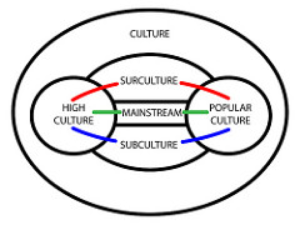21
Culture refers to the shared systems, beliefs, and values of a particular group of people. Often people who share the same culture have the same language, sense of ethics and morality, cuisine, and social habits. The figure shared below shares a visual representation of how culture operates. In this figure, culture is what embraces other, small facets of culture, such as subculture. In other words, culture is the influencer of subculture, countercultures, and the mainstream.

Visual Representation of Culture
Source: Cesar Harada, Subculture and Mainstream, Flickr, May 15, 2013, https://www.flickr.com/photos/worldworldworld/8741011624. September 6, 2018. 2.0 CC
When thinking of cultures, it is easiest for us to divide them into two types: high-context cultures and low-context cultures. However, no culture will come out and tell you if it is a high-context culture or a low-context culture. Instead you must learn about the norms of that culture in order to determine if they are a high-context culture or a low-context culture. In the sections that follow, I’ll detail what each is and give some characteristics and examples.
